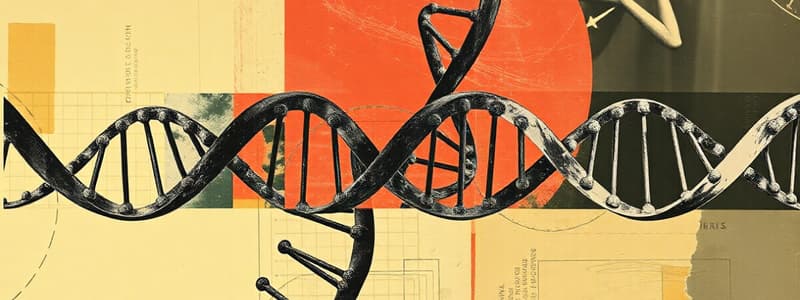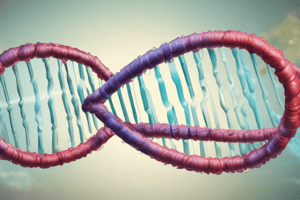Podcast
Questions and Answers
Which environmental factor can lead to epigenetic modifications affecting health?
Which environmental factor can lead to epigenetic modifications affecting health?
- Social media use
- Exercise habits
- Maternal nutrition during pregnancy (correct)
- Temperature fluctuations
Chronic stress has no effect on histone acetylation.
Chronic stress has no effect on histone acetylation.
False (B)
What role do environmental toxins, such as heavy metals, play in epigenetic modifications?
What role do environmental toxins, such as heavy metals, play in epigenetic modifications?
They can alter DNA methylation patterns associated with diseases like cancer.
The epigenome can respond dynamically to environmental changes, allowing organisms to adapt to their _____ .
The epigenome can respond dynamically to environmental changes, allowing organisms to adapt to their _____ .
Match the following factors with their effects on epigenetic modifications:
Match the following factors with their effects on epigenetic modifications:
What is the function of tRNA during translation?
What is the function of tRNA during translation?
Stop codons signal the beginning of translation.
Stop codons signal the beginning of translation.
What enzyme is responsible for transcribing a segment of DNA into mRNA?
What enzyme is responsible for transcribing a segment of DNA into mRNA?
The three-nucleotide sequences in DNA that correspond to specific amino acids are called ______.
The three-nucleotide sequences in DNA that correspond to specific amino acids are called ______.
Match the following terms with their definitions:
Match the following terms with their definitions:
Which of the following codons signals the beginning of translation?
Which of the following codons signals the beginning of translation?
Acetylation of histones generally promotes gene expression.
Acetylation of histones generally promotes gene expression.
What role do transcription factors play in gene expression?
What role do transcription factors play in gene expression?
The addition of a methyl group to DNA typically leads to ______ of gene expression.
The addition of a methyl group to DNA typically leads to ______ of gene expression.
Match the following processes with their descriptions:
Match the following processes with their descriptions:
What environmental factors can influence epigenetic changes?
What environmental factors can influence epigenetic changes?
Epigenetic changes can be inherited across generations.
Epigenetic changes can be inherited across generations.
How does the structure of chromatin affect gene expression?
How does the structure of chromatin affect gene expression?
In translation, the sequence of amino acids is determined by the ______ pairing between tRNA and mRNA.
In translation, the sequence of amino acids is determined by the ______ pairing between tRNA and mRNA.
What components make up a nucleotide in DNA?
What components make up a nucleotide in DNA?
During DNA replication, DNA ligase is responsible for separating the strands of DNA.
During DNA replication, DNA ligase is responsible for separating the strands of DNA.
What is the role of histones in the packaging of DNA into chromosomes?
What is the role of histones in the packaging of DNA into chromosomes?
In DNA, adenine pairs with ______ through hydrogen bonds.
In DNA, adenine pairs with ______ through hydrogen bonds.
Match the type of RNA with its primary function in protein synthesis:
Match the type of RNA with its primary function in protein synthesis:
Which statement about the structure of RNA is true?
Which statement about the structure of RNA is true?
Chromosomes consist of two identical sister chromatids connected at the telomere.
Chromosomes consist of two identical sister chromatids connected at the telomere.
What enzyme is primarily responsible for synthesizing new DNA strands during replication?
What enzyme is primarily responsible for synthesizing new DNA strands during replication?
Flashcards are hidden until you start studying
Study Notes
Structure of DNA
- DNA is a double helix made of two strands running in opposite directions (antiparallel)
- Each strand consists of nucleotides, which are the building blocks of DNA
- Each nucleotide is made of a phosphate group, deoxyribose sugar, and a nitrogenous base: adenine (A), guanine (G), cytosine (C), or thymine (T)
- Bases pair specifically (A with T, and C with G) through hydrogen bonds, forming the "rungs" of the ladder structure
Chromosomes
- DNA is packaged into chromosomes through chromatin formation, a process involving histones
- Histones are proteins that organize DNA into a compact structure
- DNA wraps around histone proteins to form nucleosomes
- During mitosis and meiosis, chromosomes become highly condensed and visible under a microscope
- Each chromosome consists of two identical sister chromatids joined at a region called the centromere
DNA Replication
- DNA replication is the process of copying the DNA molecule
- It involves separating the two strands by DNA helicase which breaks hydrogen bonds
- DNA polymerase then synthesizes new strands by adding complementary nucleotides to the template strands
- DNA ligase seals the gaps between sections resulting in two identical DNA molecules
- DNA polymerase acts as a proofreader, correcting errors during replication
Ribonucleic Acids (RNA)
- RNA is single-stranded and contains ribose sugar instead of deoxyribose
- It uses uracil (U) instead of thymine (T)
- RNA can fold on itself
- The three main types of RNA are messenger RNA (mRNA), transfer RNA (tRNA), and ribosomal RNA (rRNA)
- mRNA carries genetic information from DNA to the ribosome for protein synthesis
- tRNA transfers specific amino acids to the ribosome during translation, recognizing codons through its anticodons
- rRNA combines with proteins to form ribosomes, facilitating translation
- RNA polymerase transcribes DNA into RNA by copying sequences of bases on the DNA strand and forming a complementary molecule of RNA
From DNA to Proteins
- The genetic code is stored in sequences of nucleotides in DNA, grouped into codons (three-nucleotide sequences)
- Each codon corresponds to a specific amino acid
- tRNA carries the appropriate amino acid to the ribosome
- Anticodons on tRNA pair with codons on mRNA to ensure the correct amino acid sequence
- Start codons (AUG) signal the beginning of translation, while stop codons (UAA, UAG, UGA) signal the termination of protein synthesis
Transcription
- Transcription is the process of copying a segment of DNA into mRNA
- It is triggered by messengers that enter the nucleus
- The process begins with unzipping of a DNA strand by helicase enzyme
- RNA polymerase transcribes the template strand of DNA, copying the information and base pairings
- When a sequence of base pairings signals the end of a sequence, RNA polymerase detaches
Translation
- Translation is the process of decoding mRNA into a polypeptide chain by ribosomes
- tRNA and rRNA both play vital roles in translation
- tRNA carries amino acids corresponding to codons on mRNA
- Ribosomes ensure the correct amino acids are added to the growing polypeptide chain
- The anticodon on tRNA pairs with the codon on mRNA, ensuring the correct amino acid sequence
Gene Expression and Regulation
- Gene expression is influenced by factors like transcription factors, environmental conditions, and modifications to histones and DNA
- Changes in protein shape can affect their function and activity
- Acetylation is the addition of an acetyl group to the histone protein that reduces the attraction between the histone and the DNA
- Acetylation relaxes the chromatin, making it easier for RNA polymerase to access and therefore enhancing gene expression
- Methylation adds a methyl group to the DNA or histones at specific sites called cpG sites
- Methylation can both restrict access to RNA polymerase, inhibiting gene expression, or relax the chromatin, increasing transcription
Epigenetics
- Epigenetics is the study of how environmental and non-genetic factors affect gene expression without altering the DNA sequence
- Epigenetic mechanisms allow cells to respond to external stimuli and can lead to variations in phenotype without modifying the underlying genetic code
- DNA methylation involves adding methyl groups to the DNA, typically at cytosine residues
- Methylation can repress gene expression by preventing transcription factors from binding to the DNA or by recruiting proteins that inhibit transcription
- Histone modifications, such as acetylation, methylation, or phosphorylation, can alter the chromatin structure, making it more or less accessible for transcription
- Acetylation of histones generally leads to a more relaxed chromatin structure, promoting gene expression
- Epigenetic changes can be inherited across generations, impacting health and disease susceptibility in subsequent generations
Chromatin
- Chromatin is the complex of DNA and proteins (histones) that forms chromosomes within the nucleus
- The packing of chromatin affects the accessibility of DNA for transcription; tightly packed chromatin restricts access to transcription machinery, while loosely packed chromatin allows for active gene expression
- Acetylation of histones reduces their positive charge, leading to a more open chromatin structure and facilitating gene transcription
- Methylation can either activate or repress gene expression depending on the specific histone and the location of the modification
Environmental Impacts on the Epigenome
- Environmental factors like diet, stress, and exposure to toxins can influence the epigenome
- Factors such as stress, diet and drugs can lead to changes in DNA methylation and histone modifications, altering gene expression patterns without changing the underlying DNA sequence
- A diet high in certain nutrients can affect methylation patterns, while chronic stress can lead to changes in histone acetylation that influence the expression of stress-related genes
- Maternal nutrition during pregnancy can lead to epigenetic changes in the developing fetus, impacting metabolic health later in life
- Exposure to environmental toxins, such as heavy metals or endocrine disruptors, can alter DNA methylation patterns associated with diseases like cancer
- The epigenome can respond dynamically to environmental changes, allowing organisms to adapt to their surroundings
- Some epigenetic changes can be reversible, while others may be stably inherited across generations, potentially influencing traits in offspring
Studying That Suits You
Use AI to generate personalized quizzes and flashcards to suit your learning preferences.




